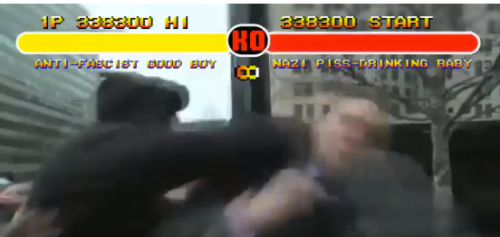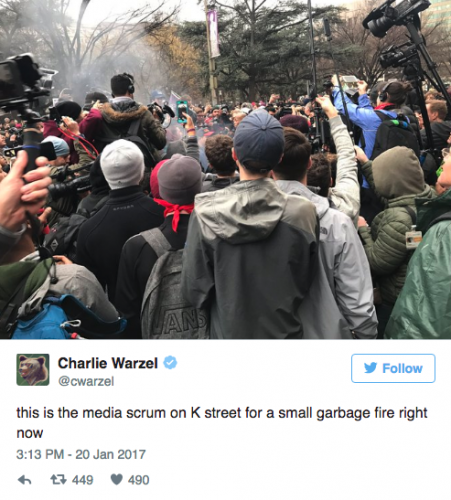Lots of people have been sharing mashups of neo-Nazi Richard Spencer getting punched in the face and, as Natasha Lennard wrote in The Nation, you can thank Black Bloc for the original source content. (My favorite right now is set to “The Boys are Back in Town.” ) Black Bloc is a tactic that has a unique relationship to attention and anonymity. Individuals mask up to remain anonymous but the collective group is meant to draw and direct attention. It is, in this way, not unlike Reddit and so it should be no surprise that black bloc is so compatible with virality. The tactic, however, was invented pre-internet and so it is worth looking at how radicals are weathering (and strategically utilizing) this relationship to digital networks and mass media.
That person who punched a Nazi may be facing up to 10 years in prison on felony riot charges if they were one of the 200 people arrested that day. Even if they escape state prosecution, white supremacists are crowdsourcing a bounty for information on the anonymous Black Bloc participant. More than a funny meme, what happened on inauguration day is a political act that is still playing out. How this event and similar ones are covered in the media has tangible consequences.
One common criticism of the Black Bloc is that white people are overly-represented in the bloc which points toward a dynamic where privileged folks are making an otherwise safe environment, dangerous. Proponents of Black Bloc tactics turn that argument on its head by saying, as Lennard does in her piece:
Not everyone can participate in a black bloc. Those with a vulnerable immigration status, or arrest records, or good reasons to fear police repression because of the color of their skin, often don’t participate in activities where the risk of arrest is high. Friday’s bloc was by no means all white, but it was predominantly white. If bearers of white privilege can do one thing, it is put ourselves on the line and take risks where others can’t.
Black Blocs draw the attention and resources of the police away from other parts of a demonstration and have even been known to “unarrest” people who have been kettled. They also, as the video of Richard Spencer attests, will violently engage people who pose a danger to others.
All of this was true before the internet though, and what has changed is the degree to which particular moments can be captured in media and precision-guided into specific audience demographics. Whereas the Black Bloc tactics deployed in years past were subject only to the framing of mass media gatekeepers, today we have access to a wider range of media producers. It is perhaps only because of individuals’ ability to record and distribute what happened on #J20 that a wider discussion of the Black Bloc can take place at all. How the Black Bloc shows up on our screens may be just as important as what the Black Bloc does in the streets.
New technologies, however, do not automatically change the common sense around political tactics. I won’t draw actual quotes from specific people but a cursory reading of the comments on Lennard’s article and in my own social media feeds indicates that Black Bloc is largely seen as a delegitimizing force. By smashing windows, openly confronting the police, and punching Richard Spencer the media narrative will decenter the message of the protestors and instead “turn violent.” That is, the cameras will seek out anything resembling a riot and largely ignore law-abiding citizens exercising their first amendment rights. When the media produces their piece on what happened that day the protestors in a permitted march get lumped in with the broken Starbucks windows and the word “incivility” gets thrown around.
Protest tactics in one form or another are all about attention and awareness. When protests are violent or destructive it is because another form of violence has been sanctioned or left unseen for a long time. That is why riots, as the Martin Luther King Jr. quote goes, “are the language of the unheard.” The decision by protestors to set a trash can (or limo) on fire is at least partially informed by the desire to direct attention. It is through empathy—the assumption that people would commit these acts because something truly bad is happening—that this tactic works. If media makers and their audiences focus only on property destruction that is a failure of empathy, not tactics. It is ironic that media Twitter loves to describe bad things as a dumpster fire only to fight for the ability to photograph actual trash fires during protests.
To put this in Stuart Hall’s terms, the idea that property destruction is never a legitimate form of protest, or that the police should never be met with resistance is part of our dominant cultural order. Protestors, according to the dominant American culture, are the ones that decide to make protests violent and police simply react when laws (and windows) are broken. This culture has taken years to cultivate but that does not mean it is immutable. Through careful work activists and media makers can popularize an alternative interpretation.
Hall argues that media making and consumption is a process of encoding and decoding. Media are encoded by their producers and decoded by audiences. Interpretations of news events are created by power elites and are broadcast by professional media producers. “When the viewer,” writes Hall in his essay Encoding/Decoding, “decodes the message in terms of the reference code in which it has been encoded, we might say that the viewer is operating inside the dominant code.” Put another way, when you don’t question how the news frames an issue, you are perpetuating the hegemonic discourse that benefits power elites in a systematic way.
Questioning or interpreting media in a way that runs counter to elites’ interests is what Hall calls an oppositional code. When reading media against the encoders intended message, the decoder must have some “alternative framework of reference.” Hall suggests by way of example that when people hear that some policy is in the “national interest” they should assume that to mean it is in the “class interest” of the elite.
What would be the oppositional code—the alternative framework of reference—for Black Bloc coverage look like? We can start by inverting many of the value connotations within the dominant code. The oppositional code should flip present common sense on its head.
It is the police’s decision, not protestors’, to make arrests. Many news outlets were quick to draw contrasts between the inauguration Day actions and the Women’s March the next day. While 200 people were arrested in the former, there were no arrests in DC, LA, and many other cities during the latter. There are countless examples, from Standing Rock to Ferguson, of peaceful protestors being violently arrested. Or, as Zeba Blay in The Huffington Post put it: “Let’s be real. A large group of mostly white women wearing knit pink hats is simply not going to be policed in same way a large group of people of color would be.” The Black Bloc was far less destructive and violent as past Super Bowl “revelers” but faced far more arrests and harsher charges.
What gets called a riot matters: The double standard of what gets called a riot and who is deserving of police violence is also a function of race and class. One could even go so far as to say that riots have been unfairly maligned. Regardless of whether riots eventually lose their negative connotation that word is used today as a means of dismissing legitimate dissent.
Assuming violent and destructive protestors have no reason to do so is the result of a profound lack of empathy. The present hegemonic discourse assumes that riots and demonstrations are collective tantrums at worst, and tragically wasted energy at best. An oppositional code interprets property destruction and violent acts as a sign of deep injustices having been ignored. This decoding scheme posits that humans do not choose violence lightly and so something profoundly wrong has taken place. Something that must be rectified and, if possible, reconciled.
Categorically denouncing the black block normalizes Trump. If open white supremacists are taking up key leadership positions in the White House, if David Duke feels like his community won a national election, then there is a much larger and more organized form of violence taking place here that must be opposed.
These are just four small steps toward what needs to be a comprehensive, totalizing, worldview that opposes our present dominant discourse. It is not (only) up to those that participate in black bloc tactics to normalize and legitimize their behavior. That is up to the people who cover and write about what happens at political events. Digital networks and media making technologies mean that a far wider range of people and perspectives can frame the discourse.
The very fact that a Nazi getting punched has gone viral is a signal that oppositional media practices are already forming and that more mainstream media outlets will look different juxtaposed to Richard Spencer getting punched to the beat of X Gon’ Give It To Ya. They will look different precisely because that viral video will breed more essays like Lennard’s, and essays like Lennard’s are what will propagate oppositional codes.
David is on Twitter.
Image is a still from this video.


